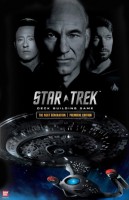
Star Trek Deck Building Game: The Next Generation
Overview – Welcome to Star Fleet
Star Trek: The Next Generation had seven successful seasons on television and won 18 Emmy awards – so naturally it has inspired hobby games of all sorts for decades. It introduced a whole new Generation (ahem) to the world of Star Trek. It’s in that spirit Bandai produced a striking deck-building experience based on the travels of Jean-Luc Picard and crew. The game is rich with Star Trek Next Gen images, references, missions and enemies. If Trek is your thing, permission granted to come aboard and learn more!
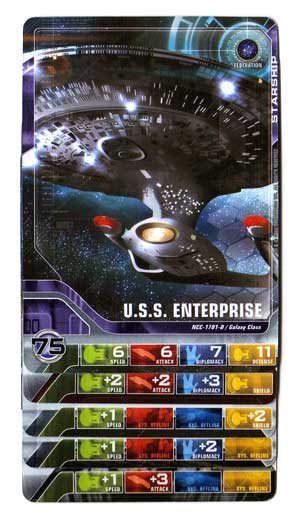
Game play – Mission Briefing
Your goal out here in unexplored space is Mission (Victory) Points. In the basic game, the first to 400 wins the game. And like other DBGs, the basic mechanic is to begin with a hand of 10 Basic cards and purchase new cards to build a deck. The card use and game play structure in this game alter that course, and take game play to a new frontier. (See what I did there?)
The key difference is 4 Statistics or “Stats” on the bottom of each player’s Flagship that allow players to accomplish missions, defeat enemy starships and engage other players in battle. These Stats are: Speed, Attack, Diplomacy, and Defense – which can also be bolstered by Shields. Two unique decks are used in the game and these control the Trek experience like a well-tuned warp engine. (ok, ok, no more obvious Trek references).
Starbase Deck
The Starbase Deck contains all the cards players will purchase and add to their hands. Cards are purchased using Experience Points (this game’s resource), usually given by Character Cards. There are two other card types in the Starbase Deck besides Characters, they are; Maneuvers and Setup cards. For the most part these have bonuses on the bottom of each card that add to the Flagships key stats listed above. Only nine individual and random Starbase cards are available for purchase at any one time in the Starbase Search Area. During their turn, players can “Search” the Starbase, discarding an upturned card and replace it from the Starbase Deck. This is a unique mechanic that cycles available cards, discarding duplicates or strategically keeping powerful cards out of your opponents’ hands.
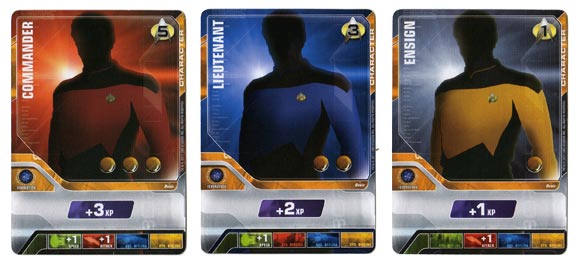
Space Deck
During their turn, players may “Explore” by flipping the top card of the Space Deck, facing whatever peril awaits them. There are three card types that make up the Space Deck: Missions (that earn players Mission Points) Starships, (that players must battle or capture) and Events (that initiate special circumstances or effects). Depending on what card is flipped, the player must assemble the best crew from their hand of cards, play them to their bridge and try to meet the goal of the Mission, defeat the enemy Starship, or face the effects of the event.
There are many finer points to the game: special card effects, rewards from completing missions, using diplomacy to capture new flagships, and even all out war! But the flow game play is as streamlined as a Romulan shuttlecraft (oops) and provides a great variance of experience that recreates the feeling of going “where no one has gone before!” (Dang it! I just can’t help myself!)
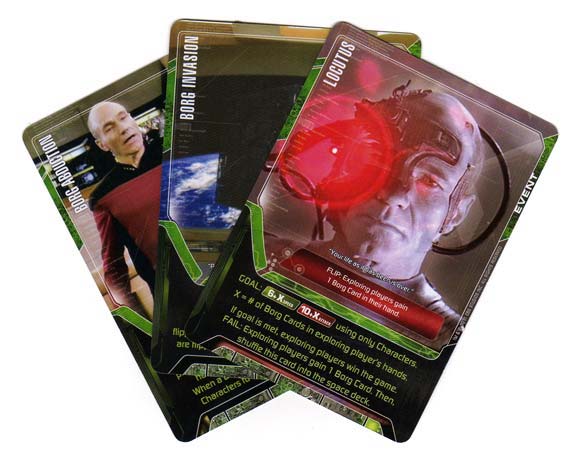
Scenarios
A standout feature of the Star Trek DBG is the creative use of “Scenarios.” Three 25 card sets that, when shuffled into the Space Deck, create a very different game play experience.
Exploration Scenario: This is the basic scenario where each player is on their own facing various missions and encounters featuring…who else? “Q.” First to 400 Mission points wins!
Borg Invasion Scenario: Players play cooperatively to stop a Borg invasion and must face and defeat the Locutus of Borg to win. Features a unique hand-filling mechanic where unwanted Borg cards add to your deck and grant bonuses to Borg attacks.
Klingon Civil War Scenario: Team Play. Players must use influence to gather as many allied starships as possible. The team that wins will convince the Arbiter they are the best qualified to lead the Klingon Empire.
Components – Fully Functional
Obviously, the cards are the main component of the game and the graphic work and image-pulls from the many seasons of Star Trek are striking. Spread out on a table they provide a feast for the eyes.
Learning Curve – No need for a Tricorder
The mechanics and game matrix are elegant and will be learned easily. Learning card effects and strategies will take continued play. The rulebook however, contains a lot of superfluous decoration and could have made better use of that space for game instructions and illustrations.
Who would enjoy this game?
Final Thoughts – Boldly go…
Let’s face it; Gamers are now very well acquainted with the Deck Building game genre. Launching a new DBG is a daunting task. In addition, Star Trek Deck Building Game: The Next Generation is one of the few deck-builders that’s based on a famous licensed property that has a huge fan base. Bandai had their work cut out for them! But Designer Alex Bykov and the rest of the design team have cleanly incorporated the key elements of Star Trek TNG into the familiar deck-building game matrix.
Star Trek Deck Building Game: The Next Generation offers reasonably fast game play, a unique starship and character stat-based game matrix and a creative use of scenarios that change the entire intention and feel of each game. It also has a unique game play quality in that late in the game, almost every card is useful and not just taking up valuable space – eliminating the need for card trashing. This game has many elements that create a true challenge for good deck-building with a real CCG feel, and it is great immersion into the Star Trek universe. So turn on the inertial dampeners, hold on to to your Klingon Targ and Engage!
User Reviews (3)
Add a Review for "Star Trek Deck Building Game: The Next Generation"
You must be logged in to add a review.

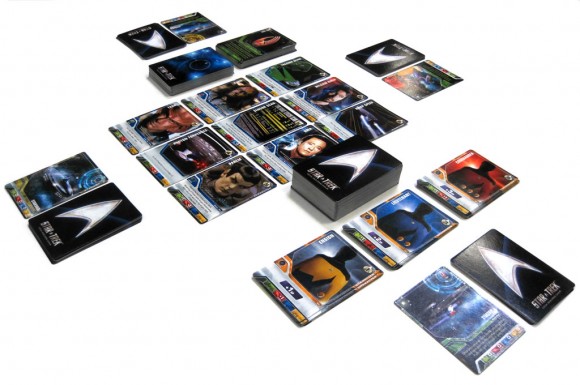

I know the main review for this game has done a really good job of explaining what the STTNG dbg is, here are my opinions…
At the present time, I’ve only played 4 deck builders – Marvel Legendary, Star Realms, Eminent Domain and this one, STTNG dbg. I played Magic the Gathering and many, many other CCGs years ago, though so I can understand and appreciate a well-balanced card game. Years ago, I played the Doom Trooper CCG and I quickly noticed how anyone with deep enough pockets to buy tons of cards for the game had a clear and distinct advantage over someone with far fewer cards. The current Deck Building Game concept counters that by giving everyone all of the tools they need to have a fun and balanced game.
As far as DBGs go, Star Trek really stands out. Star Trek gives all players an equal chance to customize their deck to their play style. The Starbase gives not only all of the better crew members, set up and maneuver cards you need to enhance your deck, it also gives you additional basic crew members which give more Resources and/or Attack abilities. Sometimes the easiest way to get from the early game to the mid game is to invest in basic crew, especially the officers.
When comparing the few DGBs I’ve played, Star Trek really works, not just for the Star Trek flavor (which it has plenty of) but the depth of play. In the early game, the players will get beat up constantly by even wimpy ships like the Ferengi Shuttle or several of the Mission cards. Later, once the players’ starships get upgraded, the race to win really gets going! Combat with random Starships is usually fast and either end in your starship being beaten badly or with another bunch of Victory points being added to your total. (An easy way to shorten the game is to reduce the Total Victory Points needed to win from the 400 point standard to maybe 300.)
(As others have pointed out, if a player gets a better starship first, they’ll have a distinct advantage over the rest. A couple of suggestions for leveling this have already been proposed but I’ll put forth my own, so check it out next.)
If I had to make one criticism, it would be in the rulebook. I had to go online to see some examples of play to really get all of it. After you get it, you can go back and re-read the rules and they make sense, but you shouldn’t HAVE to go online for a ‘translation’, although their website was the best resource I found for rules and play clarification! However, once you do the rules suddenly work for you. More examples of the different steps would be helpful. (I played it a couple of times solo before I realized when fighting a random starship, you and the attacking ship attack in one large volley (or use diplomacy) and then it’s over. The results will either be the Random Ship is taken over by using diplomacy, is defeated by you and added to your Victory points or it does it’s damage and then flies off (goes to the bottom of the Space Deck)).
The game structure is well designed and balanced (except for perhaps the already mentioned starship advantage issue). A full game creates its own story to some degree although it certainly isn’t a replay of your favorite STTNG episode, by any means. In fact, the parts of episodes are really only used as elements of game play.
A solo play game is possible although you have to pay close attention. I played the Borg Scenario and it was a blast though I failed miserably! It sort of harkened back to the Space Hulk game in that you start off thinking everything was under control and then in the span of one or two turns, everything comes unraveled!
In the end, playing STTNG dbg is fun and rewarding! I highly recommend this game, especially after watching the online help videos.
I have played this game half a dozen times. Each game was fun, interesting, and different. I’d suggest avoiding the Borg scenario, though. It can be very irritating at times, and requires truly epic amounts of coordination to be successful. I haven’t played the Klingon variant yet, though I would like to give it a shot.
Strategy tips:
Use all of your searches every round. Getting rid of cards that your opponents want is almost as useful as finding cards that you need.
There is a changeover point mid game when you no longer need XP to get cards, and instead should just focus on completing missions and defeating starships.
Defeating starships via diplomacy is far, far better than defeating them in combat. Crew is almost always better at diplomacy than combat, and cards that make you better at combat rarely do anything outside of combat.
I look forward to playing it again!
Like Star Trek? Then this game and the two expansions must be added to your collection. These games put you right in the middle of the action, just like watching one of the movies. You get to recruit crew from many races into your deck and then onto your bridge. Many of these characters add to your ships stats. You get to do missions and conquer events for victory points. You get to acquire new and better ships for your crew to use. There are several different scenarios to use in a game to mix things up. There is even a co-op game available against The Borg! This game is full of action. The two TNG games can even be combined for up to nine players. Although this will increase each players down time if no battles come up. And it is even more fun on the custom playmat. I recommend it for everyone! It will make you a Star Trek fan if you are not one yet!